#11th century spain
Explore tagged Tumblr posts
Text

Ferdinand I of León
Artist: Antonio Maffei Rosal (Spanish, 1817-1868)
Date: 1855
Medium: Oil on Canvas
Collection: Museo del Prado, Madrid, Spain
DESCRIPTION
The canvas depicts King Ferdinand I of León ( c.1016-1065 ), son of Sancho Garcés III of Pamplona , King of Pamplona, and Queen Jimena Fernandez. He promoted the Reconquista , conquering the towns of Lamego (1057), Viseo (1058) and Coimbra (1064), as well as subjecting several of the taifa kingdoms of the Iberian Peninsula to the payment of parias to the Leonese kingdom. When he died, he divided his kingdoms among his sons: his first-born son, Sancho II , was given the kingdom of Castile and the parias on the taifa kingdom of Zaragoza . His second son, Alfonso VI , was given the kingdom of León and the imperial title, as well as the parias of the taifa kingdom of Toledo . The third son of Ferdinand I, Garcia , received the es , created for that purpose, and the parias of the taifa kingdoms of Seville and Badajoz . The princesses Urraca and Elvira were given the cities of Zamora and Toro , respectively, also with royal title and their own income.
#portrait#oil on canvas#king ferdinand of leon#spanish monarch#antonio maffei rosal#male#costume#desk#crown#spanish painter#museo del prado#spanish history#19th century painting#european art#11th century spain
5 notes
·
View notes
Text

Day 25: Zaida of Seville. She was the daughter-in-law of al-Mu’tamid, the last Taifa King of Muslim Seville. When the Almoravids invaded the Iberian Peninsula, she fled to the court of Alfonso VI of León and Castile and became his mistress. She was baptized and potentially married Alfonso as Queen Isabel/Elizabeth, but Isabel may also have been a separate French noblewoman. Zaida was the mother of Alfonso’s only son Sancho.
#grayjoytober2024#zaida of seville#muslim spain#al andalus#historical women#taifa kingdoms#medieval spain#11th century#history art#traditional art#spain tag#inktober#inktober 2024#drawtober#drawtober 2024
9 notes
·
View notes
Link
“According to the Primera Cronica General, in the year 1099 the city of Valencia was under the rule of Rodrigo Diaz de Vivar, better known as El Cid. However, just three days after his death on July 10th, a huge army arrived from Tunis to capture the city. Led by a certain King Bucar, his army included “a black Moorish woman, who had 300 black Moorish women with her”. The text goes on to describe them:
All of them had their heads shaved, apart from a tuft which each of them had on the top of their head. This was because they came as if on a pilgrimage and to seek pardon. They were well armed with cuirasses and with Turkish bows. According to Abenalfarax, who was the one who transcribed this Historia in Arabic, there were at least 15,000 tents, and King Bucar ordered that black woman to station herself nearest the town with all her company.”
If this story could be true, then where did these women come from? While Lourie notes that women sometimes played roles in warfare among the Berber and Tuareg peoples of northwest Africa (the Almoravids themselves were a Berber dynasty), she believes they actually came from the Kingdom of Ghana, which lies in western Africa. Connected by major trade routes, the Almoravids and Ghana were allies, with the latter even supplying troops to assist in Iberian campaigns. Moreover, some evidence also exists of the use of women in warrior roles in Ghana. “Regiments of women warriors were known in the Western Sudan,” Lourie writes, “and therefore it is not inconceivable that a company of female archers might have served with Ghana’s Almoravid allies in Spain in 1094.”
#history#women in history#warrior women#warriors#11th century#african history#ghana#spain#black history month#medieval women#middle ages#medieval history#women's history
45 notes
·
View notes
Text
Castillo de San Servando (Toledo): vista general
Castillo de San Servando (Toledo): vista general. La última vez que estuve en Toledo, dándome un paseo por las orillas del río Tajo, vi este Castillo en el que nunca había reparado y del que desconocía su existencia. Así que tengo una asignatura pendiente: ir y verlo por dentro: El Castillo de San Servando, ubicado en Toledo junto al río Tajo, es un monumento histórico de gran…

View On WordPress
#Alfonso VI de Castilla#Alta Edad Media#Arquitectura#Castillo de San Servando#Edad Media#El Cid Campeador#En Español#España#Rodrigo Díaz de Vivar (El Cid Campeador)#Siglo XI#Toledo#Urbanismo#middle ages#Castles#Spanish Castles#architecture#military architecture#Spain#11th century
0 notes
Text
Roughly 10 Cool Historical Queer Figures More People Should Know About
Part 1 - From Ancient Era to Early Modern Era
In spirit of Pride Month here's some snippets of queer history I think are interesting.
I've been working on a series of deep dives into interesting historical queer figures, but I haven't had the time to continue my list after the first entry about Julie d'Aubigny. I do want to continue with it, but I came to the realization that I will never have to time to do all the cool and interesting figures in depth, since there's too many, so I decided to do a list with brief descriptions about some of my favorite figures who are not that well known. Some of them are more well-known than others but I think they all deserve more acknowledgement.
I was able to trim down the number of figures to (roughly) 20, which was still too many for one post, so it's two posts now. They are in chronological order, so this part is set mostly before Victorian Era and the second part will be from Victorian Era onward.
This list is centered around western history (but not exclusively) because that's the history I'm most familiar with, though it's definitely not all white, since western history is not all white. I will be avoiding using modern labels, since they are rarely exactly applicable to history, rather I will present whatever we know about these figures' gender, sexuality and relationships. If there's information about what language they used about themselves, I will use that. Often we don't know their own thoughts, so I will need to do some educated guess work, but I will lean towards ambiguity whenever evidence is particularly unclear. If you are the type of person who gets angry with the mere suggestion there's a possibility that a historical gnc person might not have been cis, I encourage you to read my answers to related asks (here and here) first before sending me another identical ask. Try to at least bring some new arguments if you decide to waste my time with your trans erasure.
1. Khnumhotep and Niankhkhnum (latter half of 2400 BCE)

Khnumhotep and Niankhkhnum were ancient Egyptian royal servants, and possibly the first recorded gay couple in history known by name. They shared the title of Overseer of the Manicurists in the Palace of King Nyuserre Ini. They both had a wife and children, but they (along with their families) were buried together in a tomb. The tomb decorations show them similarly as other afterlife couples.
2. Marinos the Monk (c. 5th-8th century)
Marinos the Monk was born as Marina somewhere in eastern parts of Byzantine Empire, likely in the Levant. He was from a wealthy Christian family, possibly Coptic. Assigned female at birth his widowed father planned to marry him off and go to a monastery himself, but he convinced his father to take him with him dressed as a boy named Marinos. His father agreed and they were accepted as monks. After his father died many years later, he continued his life as a male presenting monk. Later he was accused of fathering an illegitimate child with a daughter of an innkeeper, which was not possible, but he didn't revoke the accusations, instead he begged for the abbot's forgiveness for "his sins". Marinos was banished from the monastery and became a beggar. For 10 years he raised his alleged illegitimate child as a father, until he was allowed to return to the monastery and do penance. Only after his death the abbot and the monks discovered his genitals and his inability to father children and were distraught for punishing an innocent man for 10 long years. The real father was discovered and along with the innkeeper and his daughter they all came to honor Marinos' grave and ask his forgiveness. He was canonized as a saint for his sacrificial selflessness, modesty and humility and honored across the Mediterranean from Ethiopia to France.
3. Mubārak and Muẓaffar al-Saqlabi (c. 10th - 11th century)
Mubārak and Muẓaffar were co-rulers of Taifa of Valencia in Muslim Spain. Al-Saqlabi means literally "of the Slavs", which in Al-Andalus was a general term for enslaved northern Europeans, as the two had been enslaved as children. They were in the service of another al-Saqlabi, a chief of police, and they worked they way up as civil servants till a local military coup in 1010, which resulted in them becoming the emirs of Taifa of Valencia. English language sources often describe them as "brothers" and "eunuchs", which gives the "historical gal pals" trope a concerning twist, but contemporary Muslim sources wrote fawningly about their passionate love, trust based on equality and mutual devotion. There was a popular genre of homoerotic poetry in the Islamic world at the time and poems in that genre were written about celebrating Mubārak and Muẓaffar's relationship. In 1018 Mubārak was killed in a riding accident and Muẓaffar shortly after in an uprising.
4. Eleno de Céspedes (1545 – died after 1589)
CW: genital inspection
Eleno was born in Andalusia, Spain, to an enslaved black Muslim woman and to a free Castillian peasant. He was assigned female at birth, given name Elena, and branded as a mulatto born to a slave. She was freed as a child and married to a stonemason at 15-16 years old. When pregnant, her husband left her and died a while later. Later Eleno testified that his intersex condition became externally visible, while he gave birth, and he became a man. He left his son to be raised by a friend and traveled around Spain. After he stabbed a pimp and ended up in jail, he started presenting as a man and openly courting women. Eventually he taught himself to be a surgeon with the help of a surgeon friend.
When he married María del Caño, his maleness was questioned and he was subjected to genital inspection multiple times and it was agreed by doctors that he had definitely male genitals, possibly also female genitals. After a year of marriage the couple was accused of sodomy. Eleno was tried by the Spanish Inquisition and subjected to more genital inspections, during which no penis was found. He claimed that his penis had been amputated after an injury. He defended himself in the trial by arguing that his intersex condition was natural and he had become a man after his pregnancy, so his marriage was legal. He was sentenced only for bigamy, since he had not confirmed that his husband was dead and punished as a male bigamist with 200 lashes and 10 years of public service to care for the poor in a public hospital. His fame attracted a lot of people wanting to be healed by him, which which was very embarrasing for the hospital so he was sent away and eventually exonerated from his charges.
5. Chevaliére d'Éon (1728-1810)

Charles d'Éon de Beaumont was born to a poor French noble family. In their 20s they became a government official and at 28 they joined the secret spy network of the king, Secret du Roi. They became a diplomat first in Russia and later in Britain while they used their position to spy for the king. Rumors circulated in London that they were secretly a woman. While in London they had a falling out with the French ambassador, accused him of attempted murder and published secret diplomatic correspondence. They were instead accused of libel and went into hiding. After the death of Louis XV in 1774 and the abolishment of Secret du Roi, d'Éon negotiated with the French government of the end of their exile in exchange for the rest of the secret documents he possessed. D'Éon took the name Charlotte, claimed she was in fact a cis woman - she had pretended to be man since a child so she could get the inheritance - and demanded the government to recognize her as such. When the king agreed and included funds for women's wardrobe, she agreed and returned to France in 1777. After that she helped rebels in the American War of Indepence - was not allowed to ]go and fight too, ghostwrote her not super reliable memoir, offered to lead a division of female soldiers against the Hasburgs in 1792 - was for some reason denied, attended fencing tournaments till 65 years old and settled down for the rest of her years with a widow, Mrs. Cole. After her death a surgeon reported that she had male primary sex characteristics, but fairly feminine secondary sex characteristics, like round breasts, which might suggest she had hormonal difference/was intersex in some way.
6. Public Universal Friend (1752-1819)
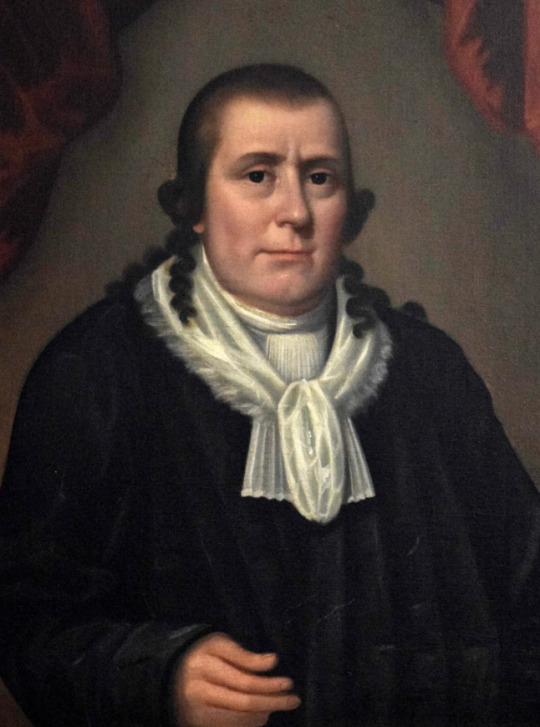
Public Universal Friend, or The Friend or PUF, was born as Jemima Wilkinson to Quaker parents in Rhodes Island, USA. Jemima contracted a disease in 1776, gained intense fever and almost died. The Friend claimed that she did die and God sent the Friend to occupy her body. The Friend didn't identify as man or a woman, and when asked about the Friend's gender, the Friend said "I am that I am". The Friend didn't want any gendered pronouns or gendered language to be used about the Friend. The Friend's pronouns, according to the writings of the Friend's followers, were "the Friend", "PUF" and possibly he. First recorded neo-pronouns perhaps? The Friend also dressed in androgynous/masculine manner.
The Friend started a bit cultish religious society disavowed by mainstream Quakers, The Society of Universal Friends, which I can only describe as chaotic good. The Friend first predicted a Day of Judgement would come in 1780 and when 1780 came and went, the Friend decided it was New England's Dark Day in 1780 and they had survived survived the Judgement Day so all was good then. The Friend preached for gender equality, free will, universal salvation (Jesus saved everyone and no one will go to hell) and abolition of slavery. The Friend persuaded any followers to free their slaves, which is probably the most chaotic good thing a potential cult leader can do with their influence over their followers, and several freed black people followed the Friend too. The Friend advocated for celibacy and was unfavorable towards marriage, but didn't think celibacy or rejection of marriage were necessary for everyone else, so it feels more like a personal preference. Many young unmarried women followed the Friend and some of them formed Faithful Sisterhood and took leadership positions among the Society.
The Society of Universal Friends tried to form a town for themselves around mid-1780s, till in 1799 the Friend was accused of blasphemy. The Friend successfully escaped the law two times. First the Friend, a skilled rider (what's a gender neutral version of horse girl?), escaped with a horse, then after an officer and an assistant tried to arrest the Friend at home, women of the house drove the men away. Third time 30 men surrounded the Friend's home at night, but a doctor convinced them that the Friend was in too poor health to move but would agree to appear at court. The Friend was cleared for all charges and even allowed to preach at the court.
7. Mary Jones (early 1800s–1853)
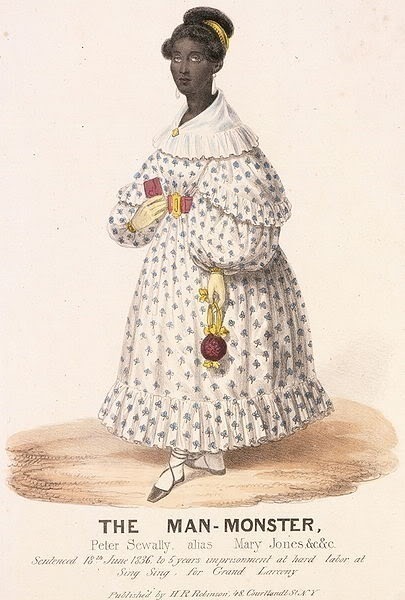
Mary Jones' origin is unknown, but she was an adult in 1836 in New York, USA. She was a free Black person, who preferred to present as a woman. She was sex worker by trade and used a prosthetic vagina. As a side hustle she would steel her customer's wallets, and usually they wouldn't tell anyone because it was 1830s and inter-racial sex and prostitution were illegal and everyone was repressed. Smart. Get your coin, girl. However after one of her more shameless customers discovered his wallet with 99 dollars inside had been replaced with a different man's empty wallet and contacted the police, she was arrested. The police discovered she had male genitals and when they searched her room they found several more stolen wallets. She appeared in court in her female presentation and when asked about her dress, she said that prostitutes she had worked with encouraged her to dress in women's clothing and said she looked better in them. They were right and she had since presented as a woman in her evening profession and among other Black people. She was convicted for grand larceny and sentenced to 5 years in prison. Later she continued to present as a woman and practice sex work, for which she was arrested for two more times.
8. George Sand (1804-1876)
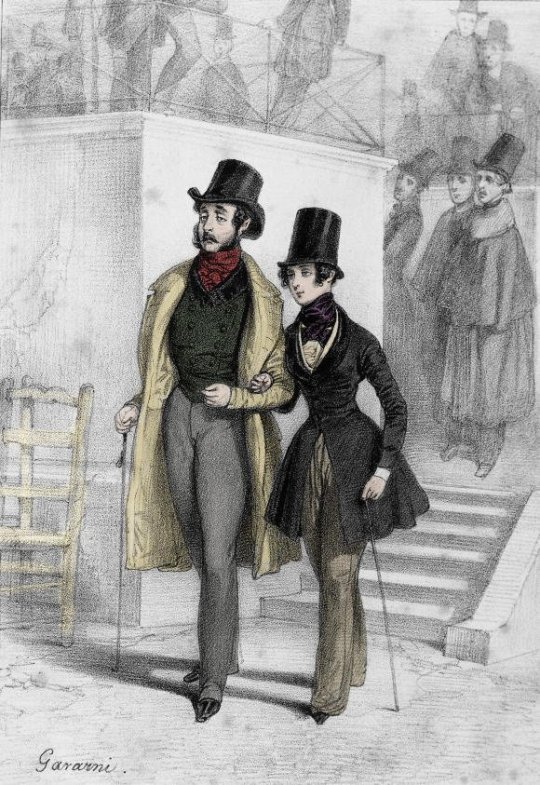
George Sand was pen name of Amantine Lucile Aurore Dupin de Francueil, a French Romantic writer. Amantine was high-born with a countess as a grandmother. George wrote about themself with alternating masculine and feminine language, using feminine language when talking about his childhood, but masculine language often other times. Their friends also used both masculine and feminine terms about them. Victor Hugo for example said about them: "George Sand cannot determine whether she is male or female. I entertain a high regard for all my colleagues, but it is not my place to decide whether she is my sister or my brother." George preferred men's clothing in public, which was illegal for those seen as women without a permit, but they didn't ask for permissions. They alternated between masculine and feminine presentations. They were outspoken feminist, critic of the institution of marriage, committed republican and supporter of worker's rights. They were married at age 18, had two children and left their husband in 1831, but legally separated from him in 1835. They had many affairs with men and some with women, at least with actress Marie Dorval. Their most notable relationship was with Frédéric Chopin, but they fell out before Chopin's death.
#i will be absolutely writing in depth posts about some of these figures#the friend is 100% one of those i fucking love the friend that story is a gift that keeps giving#history#queer history#pride month#queer#lgbtq history#queer tag#trans history#gay history#sapphic history#lesbian history#intersex history
236 notes
·
View notes
Text
Hello. Today, I'd like to make some random anecdotes about Rabbi Avraham Ibn Ezra - poet, commentator, linguist, mathmatician, probably not too bad at chess and cursed to be poor for the entirety of his life.
After a cursory look at his wikipedia page, I must admit I didn't really know much about his life: only that he was born and raised in Spain, went travelling, had terrible luck with everything, wrote his commentaries on the Torah for money (which I think didn't help with the "cursed to be poor" thing), befriended Rabbenu Tam in France, possibly married the daughter of Rabbi Yehudah HaLevi and promptly died... somewhere... oh, and also wrote lots of poetry in the middle.
Historically speaking, he lived at the end of the Golden Age of Judaism in Spain, around the 11th-12th centuries CE. This puts him right after Rashi - which allows him to snark at everything he thinks Rashi was wrong about, but before Rambam - which means he doesn't get to snark at everything Rambam got wrong. His commentary on the Torah leans a little towards the linguistic side, though he has a couple of other things going on as well, like roasting people he disagrees with (Ben Zuta is the only friend a bull has, anyone?) and dancing around verses he thinks were added later to the Torah, like every time it says "to this very day".
He also wrote one of the first math books in Hebrew - Sefer HaMispar, he wrote a poem about chess, one about how whatever he'll work at he won't get enough money. And generally, he wrote poems. Quite a lot.
I suppose at this point I should mention something: Hebrew linguists were, at the middle ages, predominantly Sepharadi. I mean, sure, there could be a non-Jewish Hebrew linguist, but for some reason I don't hear much about those. And there probably were Ashkenazi linguists, but there weren't many of them. Rashi does deal with linguistics - but half the time he does, it's using the books of two famous Sepharadi linguists. The Sepharadim, living in Muslim lands as they were, simply had a better background with learning Hebrew, since they were surrounded by speakers of a closely related language - Arabic. And Ibn Ezra's deep understanding of Hebrew led to him loving linguistic riddles, which I can never figure out - and I was reading an eddition with footnotes! Though maybe I didn't make enough effort or something.
But no, the reason I wanted to talk about Ibn Ezra was the impossible standards for poetry, as set by Sepharadi poets. You see, Jews were always influenced by their surroundings, in multiple facets. and poetry is definitely one of them. So, the influence from Arab poets includes strict rules for rhythm and - and this is what I actually wanted to talk about - rhyming.
The rythm thing is bad enough. Only once in my life have I tried keeping up with that. It was very, very hard. It's probably because I'm not used to this, but no song I write can keep a consistent rhythm and meter, and that's without trying to apply the standard Sepharadic rules. So trying to have such a strict meter... didn't work well for me. I guess I'm the frenchman from
וּמִי הֵבִיא לְצָרְפַ��ִּי בְּבֵית שִׁיר,
וְעָבַר זָר מְקוֹם קֹדֶשׁ וְרָמָס;
וְלוּ שִׁיר יַעֲקֹב יִמְתַּק כְּמוֹ מָן,
אֲנִי שֶׁמֶשׁ, וְחַם שִׁמְשִׁי וְנָמָס.
which was actually written about Rabenu Tam, but I'm a distant relative of his so this might still be applicable. Besides, as far as you know my name is Ya'akov, just like Rabenu Tam! (Sorry for not providing a translation, the gist is "how dare a frenchman trample all over poetry?!")
But rhymes. Oh, the Ibn Ezraic rhyming standards.
According to Ibn Ezra, one must always rhyme with the entire syllable. So no, just the last sound isn't enough. In Ibn Ezra's book, rhyme and dime don't actually rhyme - though I don't think he'd care about English at all. For the Ibn Ezra, shor and ḥamor can't be rhymed with each other; shor can rhyme with Mishor, and ḥamor can rhyme with har hamor, but you can't rhyme any other pair of those with each other. And I can't stay up to this challenge. It's nearly always impossible for me to find proper words to rhyme even without the extra demand for the rhyme to be the entire syllable. With English I don't think I even bothered or ever will. You have too many weird syllables for me. But with Hebrew... I do try with Hebrew, really. But I can't keep this up. And the most frustrating thing? It doesn't appear other Ashkenazi writers had this problem.
Now we get to the interesting part. I have been trying lately a new possible format for my very-anticipated-and-definitely-not-only-I-want-it Jewsade fanfic: introduction, preface and Haskamot to books. I just really enjoy reading prefaces for books, and one of my recent favourite pieces of writing is the conclusion piece of the Vilna edition of the Babylonian Talmud. If you're interested - it can be found in most editions of the Talmud at the very end of Masechet Nidah. The piece describes the trouble they went through to publish this edition of the Talmud and it's very interesting. Another favourite piece of mine is the preface of the Levush, a slightly obscure Halachic book from the time of the Shulchan Aruch. If you've ever seen me talk about the race to Halacha - this is my source for that, because the poor author was upstaged about three to four times by other people doing exactly what he planned on doing. I highly recommend this piece as well, though I don't know how easy it is to find. And the Levush - Rabbi Mordechai Yeffe - is a nice Ashkenazi guy. So he must be more lenient with his rhymes, right?
Well, I guess I didn't establish that part. Yes, the preface to the Levush starts with a poem. It's fun. It's great. It's also up to the Ibn Ezraic standard, while my attempt to write an equivalent is... not.
Huh. This post is oddly rambly. Ah well, maybe someone will like it. Anyway, the preface portion that really takes the cake is actually one from a fairly recent obscure book - like, this one was written barely a century ago. I only found it because one of my favourite singers, Aharon Razel, made a song out of it, but the song doesn't really capture the hilarity of the piece. Do ask me if you want to hear more, this one's great.
Signing off with a "darn you, Ibn Ezra! Why must you set such high standards!"
#jumblr#judaism#jewblr#jewish history#ra'aba'#rabbi avraham ibn ezra#ibn ezra#songwriting#impossible rhyming standards#random segue into prefaces for jewish religious books#Widow & brothers Rom Talmud#Levush Malchut#Ḥemdat Daniel#jewish fantasy#the jewsade#(technically)#we'll see if this ever goes anywhere
50 notes
·
View notes
Photo
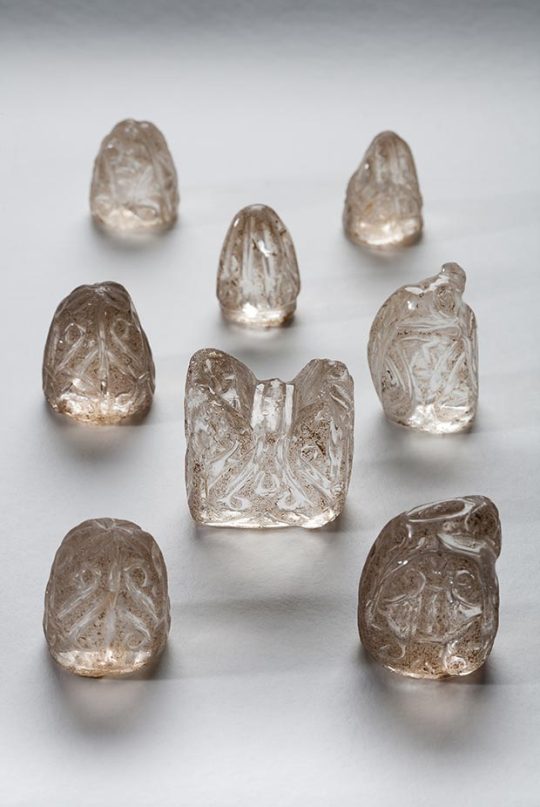
a series of 11th-century crystal chess pieces from the museo da catedral in ourense, spain .
846 notes
·
View notes
Text
'Reise Reise' turns 20 today 💿🎶
20 years from today, on the 27th of September 2004, Rammstein's fourth studio album 'Reise Reise' was released in Germany, Switzerland, Austria and several other countries. It was most likely named after the old saying "Reise, Reise!" as a signal for the sailors of a sailing ship to get up.
Recordings of this album took place in the El Cortijo Studio in Málaga, Spain, where the band gathered in November 2003. Producer for this record was once again Jacob Hellner, and a making of about this recording process and the band's time in Spain was released on the 'Völkerball' DVD in 2006. During interviews for this documentary, the bandmembers expressed that this recording session seemed to be more relaxed than the last ones, and thought about several alternative names for this album - Schneider liked the title "Rot", Flake rooted for "Nein", Paul thought about "Amerika" and "Amore" as titles, Olli liked "Reise Reise" and Richard, a bit clueles, refrained from making a suggestion. Till apparently wasn't asked or declined talking about his ideas. Documentary parts with english subtitles can be found here, here and here.
The album was originally planned as a double album, but this idea was ultimatly discarded. The following songs were recorded during the session for this album, but were used on 'Rosenrot' later: Rosenrot, Wo bist du, Mann gegen Mann, Zerstören, Ein Lied, Feuer und Wasser and Hilf mir. Additional demos exist for the following: Absinth, Eisenmann, Holz und Sonntag bei Omi.
The promotional photosession for this album was done by Olaf Heine and most likely was inspired by the movie "Falling down", starring Michael Douglas.



The cover for this album shows the outside of a aircraft's blackbox with the German imprint "Flugrekorder nicht öffnen" ("Do not open flight recorder") on it. Linked to this design, there is a hidden track before the first song on REISE, REISE - it can be heard on standard CD players by rewinding. It features radio messages (the black box recording) from the Boeing 747SR (Japan Airlines Flight 123), which crashed on August 12, 1985, killing 520 people. Up to now, it remains the deadliest single-aircraft crash in history. This dark aesthetic of all of this combined also suits the song "Dalai Lama" on the album. This song is based on the German ballad "Erlkönig", written in the 18th century by Goethe, and for this song the first instrumental tracks were written and finished for this album.
The limited digipack contained a picture from the above mentioned photoshoot.
The Japanese cover of the album is the same one that was later used for Rosenrot, a picture of the ice breaker USS Atka in the Antarctic from 1960.



As part of the promotion for 'Reise Reise', three additional CDs were published with interviews of the band members. CD 1 contained an interview with Till and Flake, CD2 with Olli and Paul and CD3 with Richard and Schneider. The linked videos contain the original soundtrack with the german interviews and a spoken english translation.




Regarding the success of this album: REISE, REISE reached number 1 in the album charts in seven countries (Germany, Austria, Switzerland, Finland, Iceland, Estonia and Mexico). After the release of REISE, REISE, Billboard declared Rammstein to be the most successful German-speaking band internationally. The album achieved 1x silver, 3x gold and 6x platinum. The song 'Mein Teil' was nominated for a Grammy. All in all, Reise, Reise reached 47th place in the Top 50 album charts of 2005.
The Reise Reise tour started with one concert (September 30th 2004) at the Label showcase party "10 Jahre Motor" and marks the only acoustic concert the band has ever played. For the occasion, the band dressed up as East Berlin police women.



After that, three concerts at the Knaack club followed on the 11th, 12th and 13th of October, 2004, where the album was presented at fan club only concerts.



Two examples for tickets for the Reise Reise tour:


Sources: rammwiki, affenknecht, rammsteinworld, rammsteinblogcollection, metal-hammer, photo.sibnet
#rammstein#reise reise#an album which really has grown on me#i love researching this stuff#happy birthday reise reise 🤍#research & rammsplaining#interviews & quotes
66 notes
·
View notes
Text
So you want to write about horses.
Specifically, you want to write about horses in your medieval-inspired fantasy novel, rpg, or daydream fantasy. Knights in shinning armor on noble steeds, damsels in distress(or not!) on fine prancing mount, or an evil sorcerer cackling on a fierce charger above your poor tandem MCs.
Whatever it is you're imagining, a medieval horse appears. But you know nothing about horses. I can help.
(If you would like to begin with my first basic Basics post, start here)

^ When thinking knight, you're probably imagining a horse like this.
Preface: When talking about fiction, there is always a question of historical accuracy. That is wholly up to you. But you will at least, after reading this, know more of the historical fact involving horses, and certainly know about some of the more commonly-complained about fallacies involving horses in media.
Now, the above still is from the film Ladyhawke (1985), which is often credited for popularizing the Friesian breed in the United States. I can almost guarantee you have see a Friesian in a film or on TV. The recent series Shadow and Bone had a central character ride a Friesian in one episode. They epitomize the romantic nobility and grace of knights. Except they don't.
The horse you see above came into existence in 1879, primarily as a harness and agricultural use horse. Horses known as Friesian horses have existed since the 11th century, but those horses were completely different from the breed created in the 19th century. The modern Friesian is a trotting breed, made to pull carriages and look beautiful doing it. They have a long back, short neck, and due to inbreeding, a host of nasty genetic problems including dwarfism, aortic rupture, hydrocephalus, and megaesophagus.
However, breeds that trace ancestry back to beyond the middle ages do exist, and they have been breed to look much the same for generations. Introducing:
The Barb/Berber Horse

^Kinda just looks like A Horse™
The Barb comes from North Africa, and was spread into Europe through the Muslim conquest of Spain, where the breed mixed with the native Andalusian breed to create the Spanish Jennet, which is possibly the most widely successful horse breed in all of history. The Jennet is currently extinct*, but due to its durability, it was the horse used by the Spanish AND the British to invade the Americas, and descendants of the Jennet survive in local breeds from Argentina to Canada.
*a revitalization breed does exist of the same name
The Andalusian/Lusitano/Pure Raza Espanol

^The true Fabio of horses, known for thick flowing locks and sweet dispositions
Possibly the horse that most strongly resembles the ancient knighly horse, this noble creature used to be the preferred horse of film, before the Friesian rise in popularity. Horses of Spanish bloodlines are Andalusian, horses of Portuguese bloodlines are Lusitano, but the characteristics of both breeds are nearly identical. They are also known for a fancy 'high stepping' movement, in which they raise their knees higher than other breeds naturally.
The Arabian

^Note the narrow, 'dished' face and raised tail, breed characteristics
The ancient horse of the desert, made famous through books such as The Black Stallion, King of the Wind, and films such as Hildago. These horses are known for their stamina and intelligence, and were traditionally used as war horses by the desert tribes of the Arabian Peninsula. The Arabian has descendants in almost all modern breeds, as it is used to add strength and stamina to the original stock, despite being a relatively small horse. During the Napoleonic wars, this horse became the prized war horse of Europe as well, with Napoleon himself preferring to ride Arabians into battle.
The Mongolian Horse

^Thick head, thick body, this horse is made to survive winter on the steppes
Introduced to Europe from the Hunnic invasions that ended the rule of Rome, the Mongolian horse is made to survive, thrive, and run in harsh cold weather. This horse allowed Ghengis Khan and his soldiers to conqure one of the largest empires to ever exist, from Korea to Poland. This compact horse would have mixed with the native stock of Russian, Eastern European, and Germanic tribes to help create the ancient northern horses, resulting in a thicker breed of horse in the north, and a lighter breed of horse in the south of Europe. Modern-day pony breeds such as the Exmoor, Fjord, Icelandic, and other have been found to have genetic ties to the Mongolian horse.
These horses do not exactly look like the modern image of knights on massive horses, but it is useful to remember that 1. people back then were a lot smaller and 2. horses back then were a lot smaller. Of course, there were hundreds of other local breeds during the middle ages, but many have been modernized and become today's sport, work, or pleasure horses.
During the middle ages, horses were not actually defined by breed. They were defined by the work the horse was suited and trained to preform. There were five main types of medieval horses.
The Destrier
Also called The Great Horse for its size, strength, and price, this horse was the renown mount of knights and kings in battle. These horses were highly trained for battle, and could be taught to do such things as striking out at soldiers in front, kicking at soldiers from the back, and even leaping all four feet in the air to protect it's rider. They would wear the most armor, and these horses would likely be closest in appearance to the modern Andalusian.
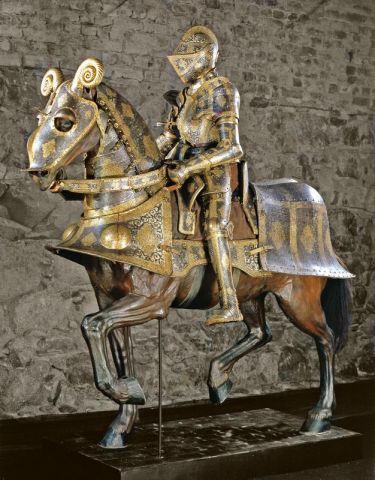
^Ornate heavy armor on a model horse. This armor was made for a horse not much more than 15hh, what today would be a small horse.
The Courser/The Charger
A lighter horse than the destrier, the courser is also a warhorse, highly trained and well-bred, but a little less expensive. A knight might not be able to afford a destrier, especially as a minor knight, but every knight should have a courser. The Spanish Jennet is the epitome of the medieval courser, and in fact was the horse used by Richard II. According to Shakespeare, the horse's name was White Surrey, although other sources claim the horse was Roan Barbary, and was a Barb or Berber horse*.
*Bought from Spain and likely a cross of Spanish and African blood, so a Jennet. But Jennet was also a classification of a horse type in those days, so, sources are muddled.
The Rouncey
The 'average' horse of the time, this horse was used mainly for riding, but could sometimes be ridden into battle if trained properly, and were the preferred horse for lower-class fighters such as archers or men-at-arms. As it described a riding horse, these horses came in all shapes and sizes, from all lineages, and in all colors. In peacetime they could be used to draw carriages or work fields. A proud and expensive destrier would never be caught pulling a plow.
The Palfrey
A highly-bred, highly trained horse, this horse is a high quality riding horse known for a specific gait, called an ambling gait. This horse had a special pattern of moving its feet that gave the rider a considerably more comfortable ride than the traditional 4 gaited horse. After the middle ages, these horses almost disappeared, only to be recovered in the Americas in the form of 'gaited' horses such as the Paso Fino, the Rocky Mountain Horse, the Missouri Foxtrotter, and the Tennessee Walking Horse. The Icelandic horse has also retained the special Tölt gait that may* be the exact gait of medieval ambling horses.
*may, I am not a gaited horse expert.
The Packhorse
This describes any kind of horse, usually a rouncey, that is used not for riding but to carry supplies. Packhorses could also be mules, donkeys, and ponies, so long as they could carry weight for long miles. These were supply horses, carrying food, weapons, tents, whatever else may be needed.
Knights, Horses, and the Battlefield

^ What an incredible creature of power and nobility. The man is fine too, I guess.
Now, if you have seen the above scene, you have probably seen The Hollow Crown, a historical drama with a few late Medieval battle scenes. In these scenes, knight clashes against knight in a furious charge, leading to pitched battles on horseback. I'm not going to say that never happened, but by and large cavalry was directed against infantry, not other cavalry, or used to conduct maneuvers requiring speed and surprise, such as a charge, a circling maneuver, a bluff retreat and most importantly, to chase down routing enemy soldiers. A knight on horseback was most effective in close quarters against unmounted and surprised soldiers. Lances were the primary weapon, allowing a mounted warrior length to spear and batter down at enemies, and a sword was secondary, as it had a shorter length, and would be used if a mounted warrior was surrounded by infantry or in battle against another knight. Throughout the medieval period, horses sometimes were removed from the fight all together due to unfavorable land, and kept in reserve to either help the army flee or to chase down the fleeing enemy.
Hungry for more?
There are many sources out there to learn more about the medieval period and knights in particular. I would highly recommend that you not look at Medieval Times sources, if only because better sources are out there. I enjoy the videos produce by Jason Kingsley CBE (Yes, that Jason Kingsley CBE) on his Modern History TV YouTube Channel, and find them to be accurate as far as I'm aware.
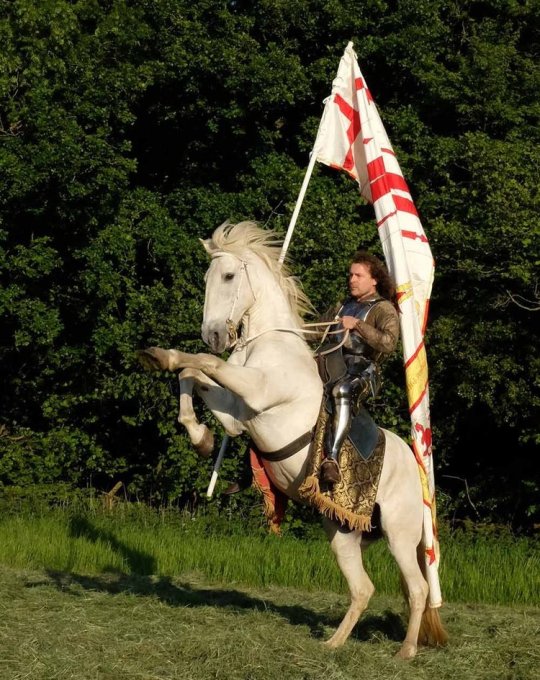
^ Jason Kingsley and his horse Warlord, in costume. I've sent marriage proposals but I've not yet received a reply.
That's all for this post. I'll have more when I feel like it, and send me questions if you want to know more about specific things or need a writing question answered
Reblogs welcome and encouraged
@jacqueswriteblrlibrary for wider reach
#writing#writeblr#writing horses#how to write horses#writer advice#writing help#writeblr community#writers on tumblr#writers#writerscommunity#creative writing#horses#how to write#advice post#medieval knights#writing medieval horses#horses in film and media#writing fiction#writer stuff#writing fantasy#writing historical fiction
204 notes
·
View notes
Text

Gilt silver panel with ivory crucifixion scene, Aragon, Spain, late 11th century
from The Metropolitan Museum of Art
227 notes
·
View notes
Text

Day 20: Almodis de La Marche. Almodis was married three times to the important lords of Lusignan, Toulouse, and Barcelona. Even through her third marriage, she remained in touch with her former husbands and their children, even encouraging Hugh V of Lusignan (her first husband) to support the claim of William IV of Toulouse (a son from her second marriage). Her sons Hugh VI, Raymond of Toulouse, and Berenguer Ramon II campaigned together on the First Crusade.
#grayjoytober2024#almodis de la marche#historical women#history art#traditional art#medieval barcelona#medieval catalonia#medieval spain#medieval france#11th century#spain tag#france tag#inktober#inktober 2024#drawtober#drawtober 2024#catalan tag
6 notes
·
View notes
Text
Pedro boys smoker matrix

Friendly discussion and even fiery debate welcome as always! 🔥
I'm back! In true Cee fashion, this idea attacked me from nowhere and I couldn't stop until I was done. This was so much fun to put together, and I have many thoughts to share under the cut.
• Masterlist •
Related posts:
How long will Pedro boys survive a zombie apocalypse?
Pedro boys as Spice Girls (R)
Pedro boys chattiness matrix
Chain smoker
Javier
The OG who makes these sucking on these cancer sticks look sexy AF, he is the only one out of the Pedro boys who deserves this accolade. Whether he's lighting up, talking around a cigarette, staring into space smoking on one - it doesn't matter what he's doing with it, he sells it.
Stress smoker
Tim Rockford, Dave York, Marcus Pike, Maxwell Lord
I wanted to put Tim in the chain smoker category, I'm convinced this stressed detective easily smokes a pack a day, but since we weren't treated to any evidence of his smoking habits, I decided to put him in this one instead. The others are pretty self-explanatory given the nature of their jobs, but can I just say - I would kill for a glimpse of Dave York smoking.
Social smoker
The Thief, Max Phillips, Nico, SNL Charlie
You know these guys wouldn't miss the chance to schmooze, especially over a cigarette.
Weed only
Dieter Bravo, Ezra, Oberyn Martell, Javi Gutierrez
I mean, if they had weed in Westeros, Oberyn would be all over it, it fits right in with his lifestyle. Both Dieter and Javi do recreational drugs in the movies, and Ezra? He gives the vibes that he grows his own weed.
Quit after kids
SNL Meemaw, Joel Miller, Frankie Morales, Jack Daniels
Don't @ me, Jack didn't lose his baby and his wife, he had two more kids and is living happily ever after 😭 We saw Joel's reaction to Tommy smoking, and I like to think that Frankie quit smoking and drugs after his baby arrived. And you just know that Meemaw used to smoke cos she's badass.
Never smoked
Din Djarin, Pero Tovar, Edward, Ricky Hauk
Din for obvious reasons of his religion, and Pero because I did some *research* and the movie is set in the early 11th century, which is before tobacco was introduced to Spain or China. But I just know that Pero would be a chain smoker in another life. It's so much fun including the two baby P's in this compilation - I've never watched Buffy or Touched by an Angel, but you can't convince me these two literal angels have ever touched a cigarette.
#tw smoking#tw cigarettes#pedro pascal#pedro pascal cinematic universe#pedro pascal characters#pedro pascal compilation#narcos#javier pena#javier peña#tlou#the last of us#joel miller#pedro pascal snl#tim rockford#dieter bravo#dave york#oberyn martell#javi gutierrez#din djarin
793 notes
·
View notes
Photo

Grossmunster
Grossmünster (“large cathedral” in German) is a Romanesque ex-cathedral situated in the heart of Zürich, Switzerland, which was built over the course of the 11th and 13th centuries CE. According to legend, the Holy Roman Emperor Charlemagne founded Grossmünster around c. 810 CE to house the bones and relics of the early Christian martyrs St. Felix, St. Regula, and St. Exuperantius who were believed to have fled to Zürich and died in city during the 3rd century CE. Grossmünster is Zürich's most recognizable and famous landmark by virtue of its iconic twin towers, and it retains a place of prominence in Protestant Christianity due to its role in the Protestant Swiss Reformation, which began at the direction of Ulrich Zwingli in 1519-1520 CE. Along with Fraumunster, Predigerkirche, and St. Peterskirche, Grossmünster is one of the oldest and largest churches in Zürich. Its triple-aisled crypt is also the largest in Switzerland.
Legends & Medieval History
Legend has it that the patron saints of Zürich - Felix, Regula, and their servant Exuperantius - were once members of the Christian Thebaic Legion, which had its base in what is now the Swiss canton of Valais. Due to the intense persecution of Christians by Roman authorities in the region, Felix, Regula, and Exuperantius fled to Zürich at some point in the late 3rd century CE. When Roman authorities in Zürich discovered their Christian beliefs, the Roman governor of Turicum - Roman Zürich - forced the three Christians to be boiled in oil and drink molten lead. Soon thereafter, he ordered the three Christians beheaded. Folklore has it that after their executions, Felix, Regula, and Exuperantius calmly picked up their severed heads and walked 40 paces - or about 27 m (30 yards) - to the place where they wished to find eternal rest and ascend to heaven. About 500 years later, Charlemagne (r. 800-814 CE) came to Zürich in pursuit of a large stag that he had seen while out hunting around Aachen, Germany. Upon arrival in Zürich, Charlemagne's horse stumbled over the graves of the three saints, and it was there that Charlemagne ordered the construction of a new church along the Limmat River: the Grossmünster Cathedral.
The basilica of Grossmünster was constructed in six stages from c. 1090-1230 CE and was erected over a 9th-century CE Carolingian building of similar dimensions. Architects made periodic renovations and structural alterations to Grossmünster in later centuries; most notably, increasing the cathedral's southern tower to match the height of the northern tower in the late 15th century CE. Grossmünster's organization and activities were overseen by the bishopric of Konstanz, Germany until the advent of the Reformation in the 16th century CE, and Grossmünster was both part of a secular canon's monastery and a parish church until that time too.
During the Middle Ages, Grossmünster's fortunes were intricately connected to those of Fraumünster, which was the nearby Benedictine convent located only 180 m (551 ft) across the Limmat River. These two churches stood facing from one another, dominating Zürich's skyline as the two largest structures in the city and as pillars of the influence and power of the Catholic Church in northern Switzerland. The two churches were, however, in perpetual rivalry with one another for control over the relics of St. Felix, St. Regula, and St. Exuperantius. The two churches shared and publically showcased these relics in an elaborate urban procession held annually on September 11th. (That day is the feast day of the three saints; this day is still celebrated as a holiday in the city of Zürich.) Zürich emerged as an important pilgrimage center by the late Middle Ages as the faithful visited the relics of the three saints while en route to other pilgrimage centers like Santiago de Compostela in Spain, the Vatican in Rome, Italy, and the Benedictine Abbey in Einsiedeln, Switzerland, which lies only 40 km (25 miles) to Zürich's southeast.
Continue reading...
26 notes
·
View notes
Text

Duruelo is a village inside the Spanish province of Soria. Its church and medieval necropolis stand out as one of the main atractions of the area.
The church of the Archangel St Michael is the result of the union of several modifications and different styles, such as the Gothic image of the Christ of Wonders (14th to 15th centuries) or the 16th century vault.
The medieval necropolis, dated back to 11th-13th centuries, was discovered in the 20th century after making some modifications inside the church.
#Duruelo de la Sierra#Soria#Archangel St Michael#Spain#Middle Ages#13th century#11th century#16th century#Christ of Wonders#20th century#medieval necropolis
1 note
·
View note
Text
@eidetictelekinetic, I'd like to follow up on something we keep discussing in comment threads to my Devil's Minion stories, because I've found the paper trail in my archives. There's indeed something I wrote as an undergraduate ca. 2005 that I had forgotten about that underpins a common theme (namely: Daniel and Armand wondering what might've happened if they'd met when they were young in Armand's time and place, when he was still mortal) periodically haunting the dialogue across my various unconnected stories. I'm somewhat in disbelief that I can prove this exists, and I needed a spark of joy like this in an otherwise bleak, snowed-out week.
This is a ghost story in that the work I'm discussing here was written under my deadname, but I don't tend to shy from people knowing it. Still, it's times like this when pieces resurface that I realize I block facets of my former self so thoroughly at times that I do my writing history a disservice. This felt like knocking down a wall, and I'm really startled at what's sitting covered in dust on the other side. Mindfuck your characters long enough and you might even mindfuck yourself.
In the spring of my senior year at Wellesley, I took a poetry seminar with Frank Bidart. He didn't like my work much, which was a source of amusement to me; if somebody doesn't like my writing, I just dig in and crank up the annoyance factor by being even more myself. The number of professors and editors that I've gone out of my way to irritate in my higher ed and writing careers is vaguely embarrassing at this point, but that's another story for another time.
At the same time as I was in this poetry seminar, I had also overloaded my schedule with Medieval literature seminars. I'd done that for about four consecutive semesters, actually. The Early Modern and Medieval course offerings at Wellesley, at least at that time, were so numerous that you really could do about two years solid of nothing but that type of coursework. I was fluent in French at the time, so I was able to pull some unhinged shit like reading La Chanson de Roland in Anglo-Norman with minimal dictionary assistance while reading it in English in one of the courses, and then I started haunting the used bookstores in Harvard Square and digging up volumes of lesser known Anglo-Norman ballads and fragments, and there was this one book that focused on early surviving trobairitz poetry, songs by women from that period. There was one fragment that really, really haunted me. I don't know if I still have the book, that's the one piece in the documentation chain I'm still hunting down, but I have my translation of that fragment because I found the poem I wrote around my translation. That poem got published twice after I graduated; that publication history is neat in its own right.
So, the poem I wrote for the seminar is really the thing I want to talk about here. I had this short 10th-11th century trobairitz ballad fragment that I translated out of Anglo-Norman, and I was very excited about it, because it was very gay. I thought, hmmm, I'll write a narrative poem about a couple of nobodies set in that time period. Who are my nobodies? I'm picturing teenagers, just a couple of boys. They can't be more than sixteen or seventeen. Where are they? I'm also taking a class on crusader states at this point in time, and I'm extremely interested in various cultural migrations in and out of Italy and Spain (the good, the bad, and the ugly). So I just go, okay, I'll have them fleeing a noble household in Italy, heading for Spain. My head's entrenched in those places thanks to a history class; it gives me something to hang onto as geographical starting and endpoints. Why are they running away? Kid attached to the noble household has fallen in love with a stonemason's apprentice from somewhere a lot further abroad; they don't speak the same language, but since when has that stopped people from falling in love? Stonemason's apprentice wants to save the kid in a bad situation in the noble household, get him out of there. Yeah, let's do that. And I'll cover just the journey, not what happens before they leave or after. And I'll show what they run into along the way, and they'll hear someone perform that piece of the song, and one of them is able to translate it for the other as they gradually learn enough pieces of common languages to communicate with each other.
This poem was never going to be long; the poems in our portfolios for this class couldn't be long. The concept work behind it was much longer than the poem itself, as was the work I put into the fragment translation. This kind of storytelling in lieu of confessional poetry was going to annoy my professor. I knew exactly what I was doing with all of this: satisfying a storytelling itch, letting myself practice translation, being the inveterate fandom writer I already was by that point, just being generally obnoxious in my early 20s. It's a living.
I wrote the poem. It got workshopped in class; classmates loved it, Frank made faces and was barely polite about it. The written feedback in it on my final portfolio called it "pseudo-medieval pastiche," and I was so happy I could've framed that shit. I put the poem away for a few years and didn't think about it. I moved to the UK and started an MA program in Medieval Studies. My poems started getting published in SF/F/Spec publications. In 2009, I learned about a call for poems for a 10th anniversary special issue of a magazine called Mythic Delirium, and something about the themed call made me remember my pain-in-the-ass, labor-of-love portfolio poem, which was called "Journeying." I submitted it.
"Journeying" was published in Mythic Delirium Issue #20, which, (in)famously, also first featured a poem by the now-disgraced Neil Gaiman called "Conjunctions." If I'm honest, it's bizarre to have that as a major point of memory in this poem's first printing. Here's how "Journeying" looks in that issue of the magazine:
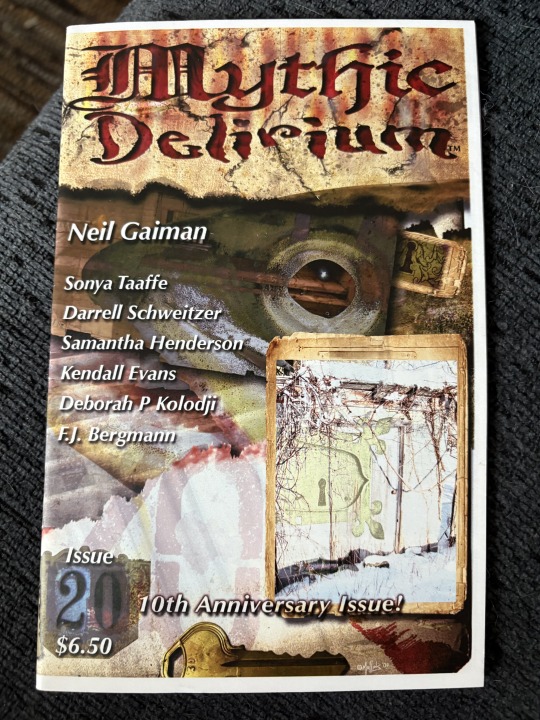


The italicized portion at the end is my translation of the trobairitz ballad. It's all that survives of one particular song that happened to be written down. It always amazes me that so few lines can express so much longing across so many centuries.
Flash forward a few more years to when I learn about Erzebet YellowBoy's brilliant Papaveria Press hand-stitched limited artbook editions of poems. One of my oldest friends, Paige (@dreambreathing) and I decide to collaborate as we've done so many times before: they did a set of two watercolor illustrations for the poem conceived as a fold-out frontispiece and backplate, and we pitched it as an artbook. Papaveria said yes. In 2012, "Journeying" was released as an edition of 18 of these little books:

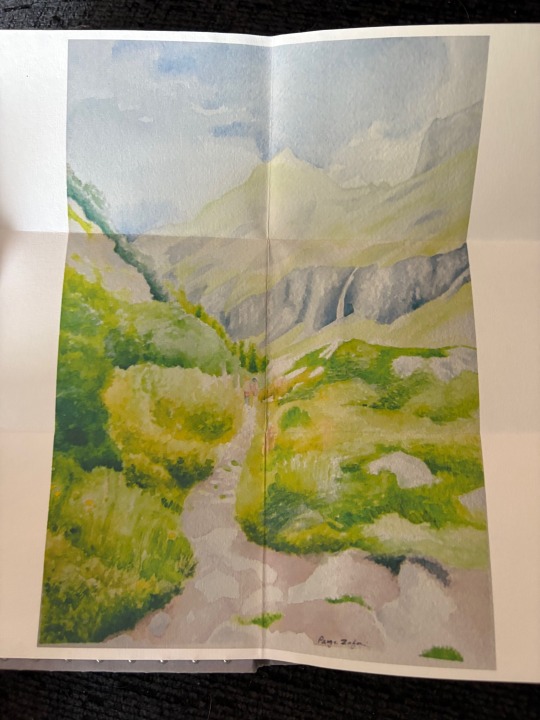
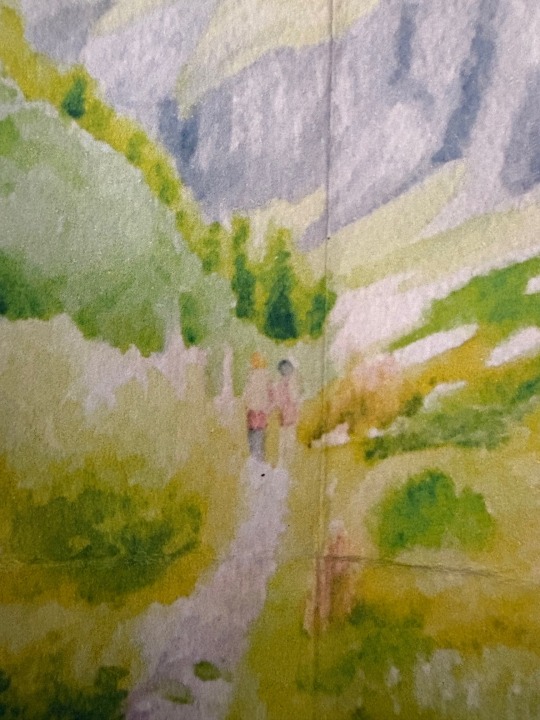

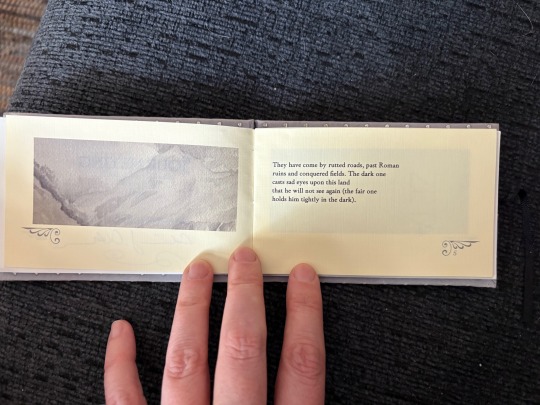




You never see the boys on the road or under the tree overlooking those ruins (those ruins, those fucking ruins, I forgot) until you pan in. Don't get distracted. Look closer. Imagine me, @eidetictelekinetic, getting more and more spooked every time we talk about this recurring thing in the dialogue I'm writing across stories. Why am I doing this? Why is it familiar? And by the time we get to "Guard Your Heart," why do I have the feeling it's hit peak hilarity by the time Daniel's looking at those Talamasca photographs?
This is an awfully long punch line, but it's here. I wrote it, some version of it, some version of them, in another life. And for me it was another life, too, a life with the name of a girl I now barely recognize. Who is Adrienne? I know that Adrienne wrote this poem, but I no longer know her as well as I would like. However, I do know that she gave up almost everything she had to give me what I have now, and I'm the writer that I am because of her. I carry these characters with me because of her; she's the one who first read them.
(Also, here's another shout-out to @dreambreathing not just for being one of my best friends through all of this and one of the most talented artists I've ever known, but also for being the namesake of my current biggest troublemaker in Caldera. Love you, Paige.)
#devil's minion#armand x daniel#poetry#art books#iwtv#interview with the vampire#storytelling#translation#medieval studies#i'm not sure how to tag this because this is a pretty strange personal anecdote relevant to an ongoing fic conversation
26 notes
·
View notes
Text

Mansilla + Tuñón, Ciudad de León Auditorium, León, Spain, 2001 VS Tessellated floor, South transept | St. Mark's Basilica, Venice, Italy, 11th - 12th century
#Mansilla + Tuñón#Mansilla Tuñón#architecture#facade#building#spain#León#Auditorium#floor#marble#tessellation#tile#tiles#basilica di san marco#venezia#venice#italy#italia#st. mark's basilica
54 notes
·
View notes